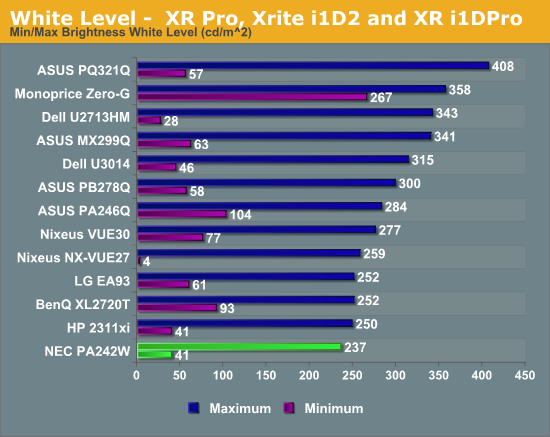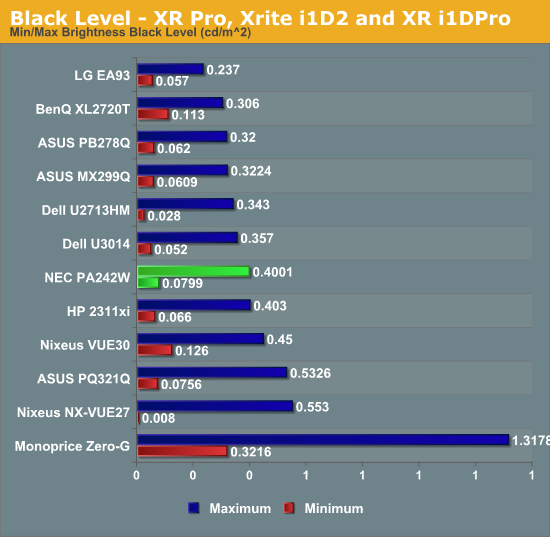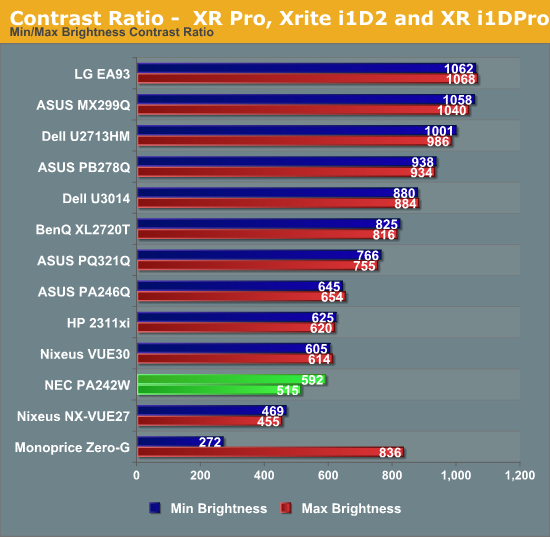NEC PA242W Monitor Review
by Chris Heinonen on September 27, 2013 9:00 AM ESTAs noted on the previous page, NEC limits the upper level of the PA242W backlight to 240 cd/m2. You can go beyond this, but the control turns red to let you know that overall performance is suffering. The construction of the PA242W is designed to make it as uniform and even a display as possible. Pushing the backlight too far will reduce that. No one that is using this monitor in a professional setting would need light output beyond that, so I used that level for the maximum setting here.
If you want to go beyond that, the NEC can produce 287 cd/m^2 at maximum. The minimum setting produces 41.19 cd/m^2, very close to the on screen reading of 40 cd/m^2. The 240 cd/m^2 setting produces 236.7 cd/m^2, also very close. You can adjust this to any level between in 1 cd/m^2 increments. For white level control, the NEC PA242W is unmatched in my experience.

Black level is not quite as good as white level. At the 240 cd/m^2 level we have a black level of 0.4001 cd/m^2 and at the minimum setting we see a level of 0.0799 cd/m^2. That is a very low minimum, but no other monitor has a minimum setting of only 40 cd/m^2 either.

The contrast ratios that result from the above are only fair, 515:1 for the minimum setting and 592:1 for the 240 cd/m^2 level. Curiously the maximum setting produces a contrast ratio of 699:1 indicating that the NEC can do better if you sacrifice uniformity. For movies and TV people typically value contrast ratio above all, but for production work, uniformity might be more important. We will see if this sacrifice winds up being worth it later.











74 Comments
View All Comments
AssBall - Sunday, September 29, 2013 - link
Wrong. It is perfectly acceptable.foxalopex - Monday, September 30, 2013 - link
Input lag? The monitor is rated for 27 ms which works out to 37 fps. Video is typically only shot at 25 or 29.97 fps. While a gamer might need more than this, video certainly isn't this fast.marqs - Monday, September 30, 2013 - link
Input lag consists of signal processing latency and pixel response time, of which only the latter limits the practical fps. By enabling overdrive the response time should improve by a couple of ms. Btw, I think the latency charts wrongly claim to be against an CRT, if the results are taken from averaging the results from Leo Bodnar lag tester (which results to ~7.5ms for a lagless CRT). The real input lag for PA242W should be around 20ms with default settings.cbelle - Monday, September 30, 2013 - link
720/60 is a standard used by many including ABC, ESPN and FOX in the US. So this is still could be an issue to video and music editors (video sync playback).Not horrendous but not great either. But if it can be lowered to 20ms that would be nice.
For video editing I think it still lacks 10 bit, SDI and video production specific needs. It is nice alternative for home editing but not sure in a suite or in the field.
Bitmambo - Saturday, September 28, 2013 - link
When will Anandtech test Eizo displays and see whether the significant price gap is justified ? One area that is hardly if ever addressed in display reviews is the bit depth of the DAC circuits, and the resultant impact on signal aliasing (Mach banding) and the quality of gradients, the signal-to-noise ratio. Uniformity, linearity, brightness, contrast ratio, response time and gamut are not all there is to display technology. Speaking of contrast ratio, we need numbers, that are not biased by the absolute blackness of the display, since anything below 1% brightness will multiply the factor enormously for not huge perceptual gain. A linearity plot showing the length of the straight portion of the gamma-corrected display should help compare display performance. Look at what the folks at Digital Photography Review do to compare cameras.TheRealAnalogkid - Tuesday, October 1, 2013 - link
...and people look at me weird because I have a second Sony GDM-FW900 Monitor in the closet for after the one I'm using dies. I'll miss them when they're gone; maybe tech will make something comparable by then.Kathrine647 - Wednesday, October 2, 2013 - link
like Gregory said I am alarmed that a stay at home mom able to earn $5886 in 1 month on the internet. visit their website............B u z z 5 5 . com open the link without spacesCSMR - Wednesday, October 2, 2013 - link
1920x1200 on a 24" is low resolution. 24" tend to be this resolution and you can see all the very large pixels. I would not recommend 24" screens for profesisonal use until manufacturers start increasing the resolution. 1440p would be perfect on this screen size.mrstonecold - Friday, October 4, 2013 - link
Does anybody now if this screen uses an active cooling element (fan) like the new eizo screens cx240 and the cg246. I'm in the market to replace my primary screen (dell u2410) and I prefer a quiet work environment. Thx.foxalopex - Friday, October 4, 2013 - link
The NEC-PA242W is absolutely silent, there is no fan. It doesn't even have a high pitched whine which is nice. The monitor is pretty thick partially for passive cooling I suspect as looking into the cooling vents at the top, you can see a massive airspace behind the actual panel hardware itself.